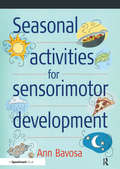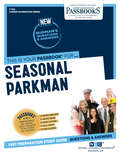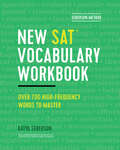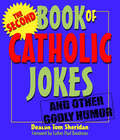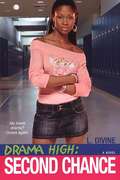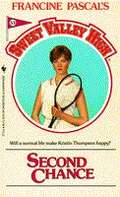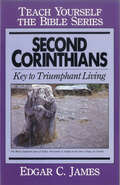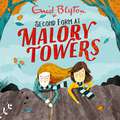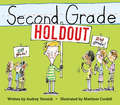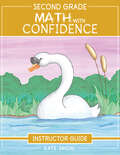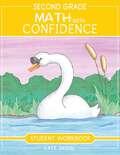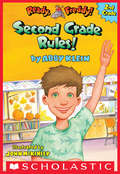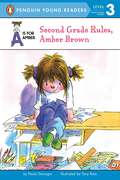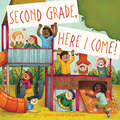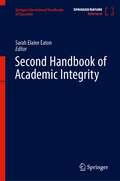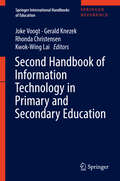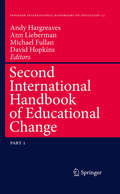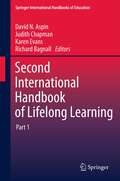- Table View
- List View
Seasonal Activities for Sensorimotor Development
by Ann BavosaThis book contains easy-to-use activities for therapists, educators and carers to provide fun and engaging sensorimotor groups for students with movement and sensory dysfunction. The activities span an entire year with a different main activity for each week. Themed by season, the activities can be linked to the school year and incorporated into the classroom. The activities promote socialisation, postural strengthening, improvement of gross and fine motor skills, and self-regulation of the body. Comprehensive instructions on how to run a group are included, as well as benefits and adaptations for severely affected individuals and wheelchair users. There are sensory-regulating warm-up appetizers to increase body awareness and prepare the students for movement; main course activities to strengthen fine and gross motor skills; and cool-down desserts to regulate the body and assimilate benefits gained during group activities. The activities are suitable for use with any school-age students, including those without movement difficulties, but are especially beneficial for students with mild to moderate motor disabilities, who exhibit increased difficulty functioning in a group setting.
Seasonal Parkman: Passbooks Study Guide (Career Examination Series)
by National Learning CorporationThe Seasonal Parkman Passbook® prepares you for your test by allowing you to take practice exams in the subjects you need to study. It provides hundreds of questions and answers in the areas that will likely be covered on your upcoming exam.
Seasons of Play: Natural Environments of Wonder
by Rusty KeelerRecent research has drawn the link between children's brain development and time spent in the natural environment. Every child deserves a safe play to play, supportive adults to watch him grow, and an environment that offers her endless possibilities. In Seasons of Play, Rusty Keeler takes readers on a photographic journey through real child care centers that have embraced his philosophy that natural play environments create new opportunities for children to explore and grow. Seasons of Play promotes play among natural elements. Using the author's own photos, the book illustrates how to design natural play environments that encourage exploration and creativity in all seasons of the year. Keeler's own drawings complement the photos with renderings of how the play spaces were designed. Interviews with center directors add a personal touch to how the spaces improve learning at the centers. Professional Development Be inspired! Watch this colorful webinar with author Rusty Keeler and see what makes Seasons of Play so special. Register with our Early Learning Book Chats community and receive a FREE CE credit for watching! - See more at: https://www.gryphonhouse.com/books/details/seasons-of-play#sthash.zhZXVI5X.dpuf
Seasons of a Dean's Life: Understanding the Role and Building Leadership Capacity
by Walter H. Gmelch Dee Hopkins Sandra DamicoWhat are the demands of being a dean? What leadership development do deans need as they progress through their academic careers? How are their responsibilities changing? What are institutions looking for in applicants?This book identifies the range of leadership skills required, and illuminates the process of building leadership capacity, by drawing on interviews with over 50 sitting deans, both women and men; on the insights derived from conducting professional development seminars for several hundred deans; and on the authors’ 48 years of collective experience in eight different deanships.The abundant examples and accounts of individual deans’ leadership successes and failures, and the competences they developed along their career paths, give the reader a taste of what the deanship is really like—and how the role changesover time. In the process of gathering their data, and tracing their own and others’, administrative journeys, the authors found similarities in how deans progress as leaders, in the common rites of passage they encounter, and in the evolution of their role. They describe the stages or “seasons” of the deanship, ranging from getting started – the first three years of deanship (springtime), to hitting your stride – years four to seven of deanship (summer), and keeping the fire alive – eight years and beyond of deanship (fall), through to planning to step down and leaving the role (winter). What also emerged from the authors’ research is that most deans come to their positions without leadership training, without prior executive experience, without a clear understanding of the ambiguity of their new role, or its responsibilities. This book fills a void by offering guidance on applying for a deanship, preparing for the role, and purposefully building the needed skills and knowledge. For anyone considering taking on a deanship, this book offers a unique window into the role. For sitting deans, it offers a compass for shaping the trajectory of their careers.
Seasons: Independent Reading Non-fiction Red 2 (Reading Champion #516)
by Jackie WalterThis book is part of Reading Champion, a series carefully linked to book bands to encourage independent reading skills, developed with UCL Institute of Education (IOE)Seasons is a non-fiction text exploring how the weather changes in different seasons. The repeated sentence structure offers readers the opportunity for a very first independent reading experience with the support of the illustrations.Reading Champion offers independent reading books for children to practise and reinforce their developing reading skills.This early non-fiction text is accompanied by engaging artwork and a reading activity. Each book has been carefully graded so that it can be matched to a child's reading ability, encouraging reading for pleasure.
Seberson Method: Over 700 High-Frequency Words to Master
by Katya SebersonFurther your SAT vocabulary knowledge to get farther down the road to successThis SAT vocabulary workbook helps students master more than 700 words that frequently appear in the SAT's reading, writing, and essay sections. The book's approach reflects changes made to the test in recent years, focusing on understanding vocabulary more than rote memorization. It's a modern workbook designed to give students the edge needed to improve their SAT scores.145 short lessons—Each lesson features a theme to help contextualize vocabulary and concludes with a mini quiz to test understanding.Practical organization—Chapters focus on different elements of the SAT, including words for reading topics like history and science, transition words, and commonly confused words.Learning that lasts—With extra tips for retention, this focused approach works equally well for students who are taking the test in a week or in a year.Perfect for summer learning—This guide makes a great summer workbook for students planning to take the SAT this coming year who want to get a head start on studying before heading back to school.Get the ideal resource for students looking to master SAT vocabulary.
Second Book of Catholic Jokes
by Deacon SherdianIn this follow up to the bestselling Book of Catholic Jokes, Tom Sheridan again offers a hilarious collection of clean and well-intentioned jokes designed to spark smiles, laughter, and maybe even a little introspection on the human condition. With a foreword by Father Paul Boudreau, The Second of Book of Catholic Jokes promises to show that faith can be--and should be--fun. SAMPLE JOKEIt was Palm Sunday but because of a sore throat, little Jonnie stayed home with a sitter. When the family returned home, they were carrying several palm fronds. Little Jonnie asked them what they were for. "People held them over Jesus' head as he walked by," his father told him."Wouldn't you know it," little Jonnie fumed, "the one Sunday I don't go and he shows up."
Second Chance (Drama High #2)
by L. DivinePicking up where Drama High: The Fight left off, Second Chance is the second in this lively, fun new series. While Jayd Jackson may have dodged the kind of drama that ends in broken bones, she may not be so lucky in the kind that ends in broken hearts. Jayd's new boyfriend Jeremy is not only cute, smart and funny--he's white, rich, Jewish, and unlike anything she's ever known growing up on the streets of Compton, a fact that neither their friends nor families seem able to overlook. Looks like navigating the halls at the predominantly white South Bay High is going to take a whole new set of street smarts--and with so much against them, can Jayd and Jeremy's romance stand up to the critics at Drama High?
Second Chance (Sweet Valley High #53)
by Francine Pascal Kate WilliamJust like everyone else... Quiet, determined Kristin Thompson knows exactly what she wants from life. Since she was little, she has had one goal -- to become a world-class tennis player. Now all she has to do is win one more tournament and she'll qualify to turn professional. Then handsome Bruce Patman invites her out and sweeps her off her feet. But there's not enough room in Kristin's life for a boyfriend and professional tennis. She begins to wonder if a romance with Bruce will make her happier than winning the tournament ever could. Will Kristin give up the dream of a lifetime to live like an ordinary teenager?
Second Corinthians- Teach Yourself the Bible Series: Keys to Triumphant Living (Teach Yourself the Bible)
by Edgar JamesThe Teach Yourself the Bible Series is one of the best New Testament studies you will find anywhere. Each book in the series is packed full of valuable questions on individual chapters of the Bible, check-ups to test your grasp of scriptural truths, and usable suggestions for group study.Grow in your knowledge of God through each New Testament book, then go on to study six aspects of Christianity essential for all believers: doctrine, prayer, eternal life, prophecy, Christian character, and Bible study.Paul's second letter to the Corinthians demonstrates the apostle's deep concern for his converts. He gives testimony to the comfort and confidence of God amid vast difficulties and speaks of the glory of his ministry in Christ. Paul also gives instruction in the grace of living.Strengthen your relationship with the living God with all twenty-five books of the Teach Yourself the Bible Series. Each volume is a timeless, yet practical, study of the Word of God.
Second Dialect Acquisition
by Jeff SiegelWhat is involved in acquiring a new dialect - for example, when Canadian English speakers move to Australia or African American English-speaking children go to school? How is such learning different from second language acquisition (SLA), and why is it in some ways more difficult? These are some of the questions Jeff Siegel examines in this book, the first to focus specifically on second dialect acquisition (SDA). Siegel surveys a wide range of studies that throw light on SDA. These concern dialects of English as well as those of other languages, including Dutch, German, Greek, Norwegian, Portuguese and Spanish. He also describes the individual and linguistic factors that affect SDA, such as age, social identity and language complexity. The book discusses problems faced by students who have to acquire the standard dialect without any special teaching, and presents some educational approaches that have been successful in promoting SDA in the classroom.
Second Form: Book 2 (Malory Towers #2)
by Enid BlytonWelcome to Malory Towers, where there's more to life than lessons!Darrell Rivers is excited to be going into her second year at Malory Towers - but is she ready for the drama it will bring? Jealousy flares when a new head of the form is chosen, and the girls become suspicious when their belongings go missing. Who could the thief be? And why on earth has timid Mary-Lou ventured out during a terrible storm?Now a 5* stage production and coming to TV on CBBC soon!Between 1946 and 1951, Enid Blyton wrote six novels set at Malory Towers. Book 2 was first published in 1947. This recording is based on the classic text.*(P) 2019 Hodder & Stoughton LimitedMalory Towers ® Enid Blyton ® and Enid Blyton's signature are registered trade marks of Hodder & Stoughton Limited. No trade mark or copyrighted material may be reproduced without the express written permission of the trade mark and copyright owner.
Second Form: Book 2 (Malory Towers #2)
by Enid BlytonWelcome to Malory Towers, where there's more to life than lessons! Now adapted for TV on CBBC.Darrell Rivers is excited to be going into her second year at Malory Towers - but is she ready for the drama it will bring? Jealousy flares when a new head of the form is chosen, and the girls become suspicious when their belongings go missing. Who could the thief be? And why on earth has timid Mary-Lou ventured out during a terrible storm?Malory Towers is now on TV on CBBCBetween 1946 and 1951, Enid Blyton wrote six novels set at Malory Towers. Book 2 was first published in 1947. This edition features the classic text and is unillustrated.*Malory Towers ® Enid Blyton ® and Enid Blyton's signature are registered trade marks of Hodder & Stoughton Limited. No trade mark or copyrighted material may be reproduced without the express written permission of the trade mark and copyright owner.
Second Form: Book 2 (Malory Towers #2)
by Enid BlytonWelcome to Malory Towers, where there's more to life than lessons! Now adapted for TV on CBBC.Darrell Rivers is excited to be going into her second year at Malory Towers - but is she ready for the drama it will bring? Jealousy flares when a new head of the form is chosen, and the girls become suspicious when their belongings go missing. Who could the thief be? And why on earth has timid Mary-Lou ventured out during a terrible storm?Malory Towers is now on TV on CBBCBetween 1946 and 1951, Enid Blyton wrote six novels set at Malory Towers. Book 2 was first published in 1947. This edition features the classic text and is unillustrated.*Malory Towers ® Enid Blyton ® and Enid Blyton's signature are registered trade marks of Hodder & Stoughton Limited. No trade mark or copyrighted material may be reproduced without the express written permission of the trade mark and copyright owner.
Second Grade Holdout
by Matthew Cordell Audrey VernickSecond grade? Pfff! No, thanks. The comically anxious narrator in this book thought that first grade had its problems, but overall it was pretty awesome. He'll take grade one over grade two any day, thank you very much! Especially because he and Tyler, his best friend, will not be in the same class this school year. On top of that, Tyler's sisters have been feeding the boys a steady stream of rumors about the horrors of second grade. Luckily they catch on that just maybe some of those stories are not one hundred percent true. Could it be that second grade is not so bad? Find out in this laugh-out-loud story that has more than its fair share of heart.
Second Grade Math With Confidence Instructor Guide (Math with Confidence #7)
by Kate SnowA scripted, open-and-go program that will have you teaching math confidently--even if you’ve never taught math before. From popular math educator Kate Snow, this easy-to-use program will give parents the tools they need to teach Math with Confidence—even if they’ve never taught math before. Short, engaging, and hands-on lessons will help children develop a strong understanding of Second Grade math, step by step. reading, writing, and comparing numbers to 1000 adding and subtracting 2- and 3-digit numbers solving addition and subtraction word problems telling time, counting money, and measuring length reading graphs, identifying 2-D and 3-D shapes, and understanding simple fractions Children will develop both strong number sense and a positive attitude toward math with fun activities like Pretend Restaurant, Measurement Tag, and Fraction Bump. All you’ll need are this Instructor Guide, the Student Workbook, and simple household items (like play money, base-ten blocks, a clock, and a ruler) to make math come alive for children. Short, hands-on, and developmentally-appropriate lessons Games and pretend activities make math fun Easy to use, with clear directions and explanatory notes Delightful (and optional) weekly enrichment lessons, with picture book recommendations and real-life math extension activities Memory work and daily review to ensure children retain what they’ve learned and master essential skills
Second Grade Math With Confidence Student Workbook (Math With Confidence Ser.)
by Kate SnowA colorful, engaging workbook to reinforce and practice the skills taught in the Second Grade Math with Confidence Instructor Guide. Simple and straightforward workbook pages give children practice with new concepts and provide daily reviews of previously learned skills. Short, simple pages give children written practice without tiring small hands Daily review helps children retain what they have learned. All answers are provided in the Instructor’s Guide for easy correcting Colorful, whimsical illustrations Age Range: 7-8 Grade Range: Second Grade full-color illustrations on every page.
Second Grade Rules! (Ready, Freddy! 2nd Grade #1)
by Abby KleinFreddy is back -- and he's ready for second grade!Freddy likes his new second-grade teacher, but he doesn't like being stuck with Max and Chloe -- especially since his best friend, Robbie, is in another class! Is Freddy ready to reach out to the new student, Josh, and make a friend?
Second Grade Rules, Amber Brown
by Paula DanzigerSecond grade is almost as wonderful as Amber expected, but there's one problem: the rules. Most of them are easy for Amber, but she just can't manage to keep her desk clean.
Second Grade Rules, Amber Brown (A Is for Amber #5)
by Paula DanzigerAmber Brown thinks that second grae rules! But when her teacher says desks have to be kept clean, Amber knows that is one rule she cannot follow. She desperately wants the desk fairy, Deskarina, to visit her desk and leave a reward. A messy desk never bothered Amber before, but now that a treat is involved, it does...Following closely on the events in Get Ready for Second Grade, Amber Brown, kids and teachers will applaud this hilarious take on a universal classroom issue.
Second Grade, Here I Come! (Here I Come!)
by D.J. SteinbergGo back to school for second grade—and get ready to go with these fun and silly poems!D. J. Steinberg's heartfelt, relatable, and silly poems bring to life the highlights of second grade—reading those big-kid books, trying out for the school play, and even dance breaks to wiggle "arms and legs and kaboodles. . . like a big bunch of second-grade noodles!" Covering an entire school year of holidays, memorable moments, and important life lessons, this is perfect for soon-to-be second graders!
Second Handbook of Academic Integrity (Springer International Handbooks of Education)
by Sarah Elaine EatonThe book brings together diverse views from around the world and provides a comprehensive overview of academic integrity and how to create the ethical academy. At the same time, the Handbook does not shy away from some of the vigorous debates in the field such as the causes of academic integrity breaches. There has been an explosion of interest in academic integrity in the last 20-30 years. New technologies that have made it easier than ever for students to ‘cut and paste’, coupled with global media scandals of high profile researchers behaving badly, have resulted in the perception that plagiarism is ‘on the rise’. This, in combination with the massification and commercialisation of higher education, has resulted in a burgeoning interest in the importance of academic integrity, how to safeguard it and how to address breaches appropriately. What may have seemed like a relatively easy topic to address – students copying sources without attribution – has in fact, turned out to be a complex, interdisciplinary field of research requiring contributions from linguists, psychologists, social scientists, anthropologists, teaching and learning specialists, mathematicians, accountants, medical doctors, lawyers and philosophers, to name just a few.Because of this broad interest and input, this handbook serves as the single authoritative reference work which brings together the vast, growing, interdisciplinary and at times contradictory body of literature. For both established researchers/practitioners and those new to the field, this Handbook provides a one-stop-shop as well as a launching pad for new explorations and discussions.
Second Handbook of Information Technology in Primary and Secondary Education
by Joke Voogt Gerald Knezek Rhonda Christensen Kwok-Wing LaiIn this second edition the editors continue their efforts to synthesize research and practice and project future directions in the field of information and communication technology. The proliferation of mobile devices and applications have had major implications on how the nature of teaching and learning should be conceptualised, and what pedagogical practices should be used to support bridging formal and informal learning. The advent of social media also highlights the importance of gaining a deeper understanding of social learning theories and computer-supported collaborative learning theories and practices. The advancement of new technologies to support easy accessibility of educational resources such as OER and to a lesser extent MOOCs have led to the debate on how assessment should be conducted and how technologies could be used to support it. The demand of the knowledge society requires that researchers, policy makers, and educational practitioners be conversant with new research findings in order to understand the impact of ICT in teaching and learning, and how to support learners to use new technologies and applications creatively and effectively. New research paradigms have emerged to meet these challenges.
Second International Handbook of Educational Change
by David Hopkins Andy Hargreaves Michael Fullan Ann LiebermanThe two volumes of the second edition of the International Handbook of Educational Change comprise a totally new, and updated collection of the most critical and cutting-edge ideas in educational change. Written by the most influential thinkers in the field, these volumes cover educational change at both the theoretical and practical levels. The updated handbook remains connected to the classical concerns of the field, such as educational innovation, reform, and change management, and also offers new insights into educational change that have been brought about by social change and shifting contexts of educational reform. Like the first best selling Handbook, this one will also undoubtedly become an essential resource for people involved in all spheres of education, from classroom teachers, teacher leaders and administrators to educational researchers, curriculum developers, and university professors. No other work provides such a wide-ranging and comprehensive examination of the field of educational change.
Second International Handbook of Lifelong Learning
by Karen Evans Richard Bagnall David N. Aspin Judith ChapmanThe second edition of the International Handbook of Lifelong Learning is extensive, innovative, and international in scope, remit and vision, inviting its readers to engage in a critical re-appraisal of the theme of "lifelong learning". It is a thorough-going, rigorous and scholarly work, with profound and wide-ranging implications for the future of educating institutions and agencies of all kinds in the conception, planning and delivery of lifelong learning initiatives. Lifelong learning requires a wholly new philosophy of learning, education and training, one that aims to facilitate a coherent set of links and pathways between work, school and education, and recognises the necessity for government to give incentives to industry and their employees so they can truly "invest" in lifelong learning. It is also a concept that is premised on the understanding of a learning society in which everyone, independent of race, creed or gender, is entitled to quality learning that is truly excellent. This book recognises the need for profound changes in education and for goals that are critically important to education, economic advancement, and social involvement. To those concerned about the future of our society, our economy and educational provision, this book provides a richly illuminating basis for powerful debate. Drawing extensively on policy analyses, conceptual thinking and examples of informed and world-standard practice in lifelong learning endeavours in the field, both editors and authors seek to focus readers' attention on the many issues and decisions that must be addressed if lifelong learning is to become a reality for us all.
